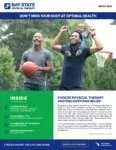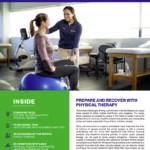More than 50 million Americans suffer from chronic pain every day. For many of those individuals, movement can be challenging and might even seem impossible at times. The Cleveland Clinic defines chronic pain as pain that lasts for over three months, can occur anywhere in your body, and can be present all the time, or it may come and go.
Did you know that pain becomes chronic because we let it? That might seem scary—but flip it to the positive. You don’t have to let pain become chronic; you can take control of your pain before it begins to control you. How? The team at Bay State Physical Therapy can help!
What Causes Chronic Pain?
Pain can become chronic when the cause of the initial pain isn’t recognized or treated as a problem. For example, you might start training for an upcoming local bike race—or just dust off the gears to enjoy the nice weather! However, you begin to experience low-back pain during your rides and throughout the day.
Most of us usually don’t listen to our bodies or don’t take the necessary steps to reduce the pain. Instead, we continue, as usual, thinking the pain will go away on its own. Perhaps, what you’re feeling is normal muscle soreness, that lessens over the next day or so. However, that’s not always the case. If this pain doesn’t resolve, before long you become accustomed to the constant ache. Then, you ease off the activities that cause more pain, and before you know it, you’ve missed out on more than just that race you trained so hard for!
How Does Ignoring Pain Make It Chronic?
Ignoring pain often prolongs pain. When an injury occurs, various nerves send information from the problematic areas in the body to the brain. The brain then takes this information and determines if action must be taken to prevent further harm. When the pain is constant, the brain and nervous system switch to high alert, making them extremely sensitive. Unfortunately, this sensitivity makes the brain interpret many sensations as threatening, which then makes it send more pain signals to your body even if there’s no actual threat. At this point, emotions, stress, or reactions to external life factors can trigger physical pain when no threat or injury is present.
In short, prolonged pain can cause a disconnect between the brain and body—which means your body might accidentally trick your brain into thinking it’s hurt all the time. The result? Chronic pain.
Four Ways Physical Therapy Helps Manage Chronic Pain
With innovative techniques, stretches, and exercises, physical therapy will give you the tools and care you need to fight your pain before it becomes chronic. Remember: when it comes to pain, you’re in control—and you can take proactive steps to stop it in its tracks. Here are four ways working with a physical therapist can help you manage chronic pain and return to the activities you love.
Early Detection
Sometimes, injuries happen. That’s life! The most important way to stop injury pain before it becomes chronic is to recognize it and treat it early. So, at the first sign of injury or pain, call your physical therapist. They’ll identify the root cause of your pain and determine the appropriate steps for treatment.
Manual Therapy
Staying up to date on the latest industry innovations and best practices, physical therapists can use their expertise in hands-on care, joint mobilization techniques, dry needling, Kinesio taping, cupping, and other strategies to ease pain and encourage healthy movement.
Strength & Flexibility Training
Have you ever heard the saying ‘Movement is medicine’? Exercise is proven to decrease inflammation, increase mobility, and decrease overall pain. Instead of letting chronic pain limit your movement, physical therapy uses movement to strengthen your muscles and heal your chronic pain!
Injury Prevention
A physical therapist can help identify postural faults, muscle imbalances, and errors in positioning that could otherwise make you susceptible to injury. For instance, activities such as bike riding can place stress on the spine. This could lead to stress on the structures of the spine such as the intervertebral discs, making them more vulnerable to injury. Your physical therapist could educate you on proper posture to use while riding your bike and give you tailored exercises to strengthen the muscles needed to support that posture so you can protect your spine and prevent injury in the first place.
DON’T PROLONG PAIN. PREVENT IT!
Chronic pain can be debilitating, but relief—and more importantly, prevention—is possible. Take the first step toward healing by calling Bay State Physical Therapy and get back to the active lifestyle you and your loved ones deserve!
To learn more, call your nearest Bay State Physical Therapy location or complete the form below to request an appointment.
Tags: injury prevention, Aches, Chronic Pain, health and wellness






